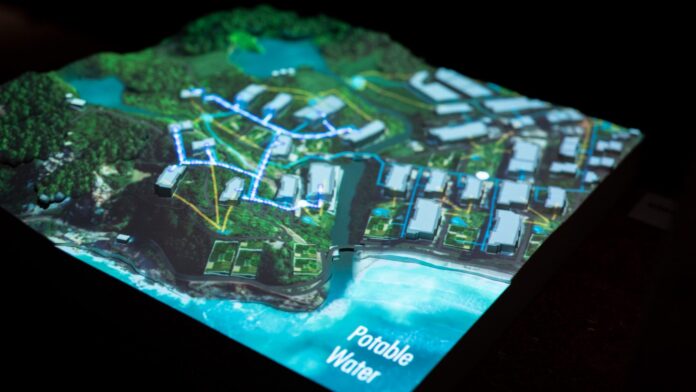The first Symbiocene concept uses the floating islands made from layers of reed, on which the Ma’dan build their homes in the marshes of southern Iraq, to help retrofit coastal communities so they can survive higher sea levels.
This would involve jacking up lighter at-risk structures like single-family houses and building a structure underneath so they can be lifted onto reed islands and turned into off-grid homes with their own energy supply and composting toilets.
“When the reeds decompose, they trap air so they create these buoyant bubbles, which means that the islands are floating,” Mordak told Dezeen.
By using the land and the resources it has to offer this gives the opportunity for there to be sustainable communities than use natural resources in a way that doesn’t hurt the environment. This can relate to the way Indigenous people had their own techniques to use what was available to them to create their sustainable communities. It goes back to that code of ethics Indigenous tribes had of only taking what you need from nature so that the well-being of the land can be maintained.
“And then you can create homes on them, you can farm on them because the layers upon layers of the reeds create an island and an earth. And underneath the islands, there are these amazing bio-havens that provide habitat for water life.”

The second concept uses a trellising technique, which the War Khasi people use to construct bridges from living trees, to form a network of covered walkways connecting city dwellers to public transport stations.
Ficus trees with aerial roots would be planted at different levels over bamboo scaffolds and their roots and branches trained to form dense roof structures that can shield pedestrians from rising temperatures.
“This is particularly relevant in climates where it’s getting hotter and actually cycling or walking for any distance is getting increasingly uncomfortable and difficult,” Mordak said.
“The trees provide shade, improve air quality and lower surface temperatures through the process of evapotranspiration. That’s going to make a big difference to how far people are willing and able to use those sustainable forms of transport.”
The final Symbiocene concept hopes to tackle the problem of water scarcity by moving away from a centralised “out of sight out of mind” water management system.
Instead, it proposes establishing small cooperatives at neighbourhood level, based on the Subak system used in Bali to irrigate rice terraces, which would see locals work together to distribute water according to need and encourage them to use this finite resource more responsibly
“Because water is managed at a local level with a small group of people, it’s not abstract,” Mordak said. “So you’re going to think much more carefully about what you use, and you will be able to see the results.
All of these concepts listed above use Traditional Ecological Knowledge (TEK) for these modern applications. Climate change has an impact on these urban and coastal communities and the approach this installation took was to show how they can use TEK to adapt to rising sea levels, increasing temperatures, and water scarcity, while maintaining harmony with nature. There was so much value in this installation too, it allowed visitors to see the opportunities and potential that Indigenous wisdom can offer present-day.
Source: Hahn, J., & Hahn, J. (2022, July 11). Buro Happold works with indigenous builders to develop climate resilience strategies for cities. Dezeen. https://www.dezeen.com/2022/05/19/buro-happold-symbiocene-our-time-on-earth/
Buro Happold. (2023, August 30). Our Time on Earth: The Symbiocene – Buro Happold. https://www.burohappold.com/projects/our-time-on-earth-the-symbiocene/




